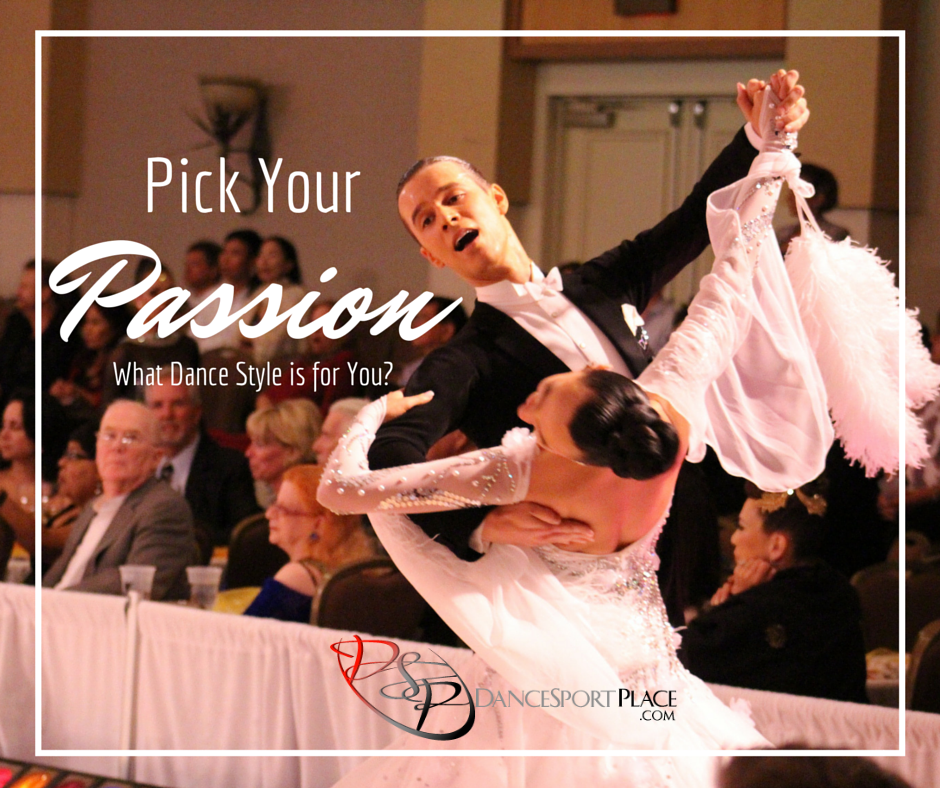So, you’re passionate about dance, but not sure…what dance style is for YOU?
You might have seen or heard of a dance that makes your feet itch for the dance floor, but often new dancers head to the studio thinking they want to learn ONE thing, and find out their passion is really for ANOTHER style altogether.
Then there’s the confusing classifications. Newbies might be surprised that:
- Tango is not a Latin dance…but Jive is.
- Asking to learn “Swing”, is like saying you want a pair of “black shoes.” Do you want East Coast, West Coast, Lindy Hop, Jitterbug, or Country Swing?
- International Rumba & American Rumba have different patterns, timing, hip action, and characterization…but they’re both called Rumba.
- Want to learn samba for your trip to Rio de Janeiro? Well, sorry, but that Samba is not OUR samba.
Needless to say, dance lingo can be as complex to wrap your head around as your first try at pivots!

Thanks to shows like “Dancing with the Stars” & “So You Think You Can Dance”, your non-dancing neighbor now knows that chasse is pronounced shah-SAY, not SA-shay.
But, even on those shows, you’ll see the typical categorizations are not followed. Which leads to starry-eyed new dancers dreaming of getting their groove on to Jives and Argentine Tangos; two dances which generally wouldn’t be taught together.
There are 19 different competitive dances in dancesport competition. That’s a lot to keep straight!
These 19 dances are groups into 4 sets of competitive styles:
- Ballroom
- Latin
- Rhythm
- Smooth
And if you’re a social dancer, there are even more possibilities to add into the mix.
So, before you call up the local studio to start your dance lessons, here’s a primer so you’ll know exactly how to answer when asked:
What dances do you want to learn?
International Standard (Ballroom):
Waltz Tango Viennese Waltz Foxtrot Quickstep
current World Ballroom Champions- Arunas Bizokas & Katusha Demidova (USA)
The International dances are based on a WORLDWIDE standard and syllabus. These dances are most usually used for competitive dancing. A dancer who dances both the Latin and Standard styles is called a 10-dancer.
The five dances listed above are now simply referred to as “Ballroom”. Formerly, this group was called Standard, and even further back, Modern.
Ballroom dancers do not break away from each other at all and remain in frame throughout.
The Waltz and Foxtrot tempos are slower then in the American Style, and the Tango and Viennese Waltz are faster. Some might characterize this as the most disciplined of the groups of dance styles.
International Latin:
Cha Cha Samba Rumba Paso Doble Jive
current World Latin Champions- Riccardo Cocchi & Yulia Zagoruychenko (USA)
The Latin dances are sexy, rhythmic and feature a lot of play between the partners. Unlike the ballroom dances, changes in holds are integral to this set of dances, moving partners from closed positions, to open and everything in between.
Most of the dances in this category are fast-paced and are physical. Although Rumba is listed in both the International and American categories, the two rumbas are almost entirely different dances in their respective categories, although sharing the same name.
American Smooth
Waltz Tango Foxtrot Viennese Waltz
current World Smooth Champions- Peter & Alexandra Perzhu (USA)
The American dances are popular both for social dancing and competitive dancing. Socially, there are a great many variations for each of the dances which can be easily led.
These two divisions are almost exclusively danced in the US and Canada. A dancer who dances both the Rhythm and Smooth styles is called a 9-dancer.
Smooth dancing takes the best of both Ballroom and Latin dancing and blends them into a uniquely elegant yet showy style. You can see the origins of smooth dancing in the classic films featuring Fred Astaire and Ginger Rogers.
This group of dances is perfect for those who love both the openness and play between partners like in the Latin dances, yet also enjoy the structure of the ballroom dances.
American Rhythm:
Cha Cha Rumba East Coast Swing Bolero Mambo
current World Rhythm Champions- Emmanuel Pierre-Antoine & Liana Churilova (USA)
The Rhythm dances share similarities with the Latin dances in character and the use of hip action and body rhythm, but there is little overlap in the actual dances.
Although both styles feature the rumba, these rumbas are different both with their basic steps and timing, and share little else besides the same name. Leg action is also different in the Rhythm, which accentuates a bent knee when stepping.
Nightclub Dances:
Salsa West Coast Swing Argentine Tango Lindy
current US Open West Coast Swing Champions-Jordan Frisbee & Tatiana Mollman (USA)
- Write your Dance: Improve your dancing through journaling - November 12, 2019
- The Difference Between Oversway and Throwaway: Ballroom Video Preview - June 8, 2018
- Principles of Movement: Ballroom Basics Video - September 21, 2016





Thanks for sharing, I found it extremely helpful! 🙂
Thanks for stopping by! Glad you liked the article 🙂
Many ballroom dance styles have rich cultural and historical backgrounds. Learning these dances can provide insight into different cultures and their traditions.